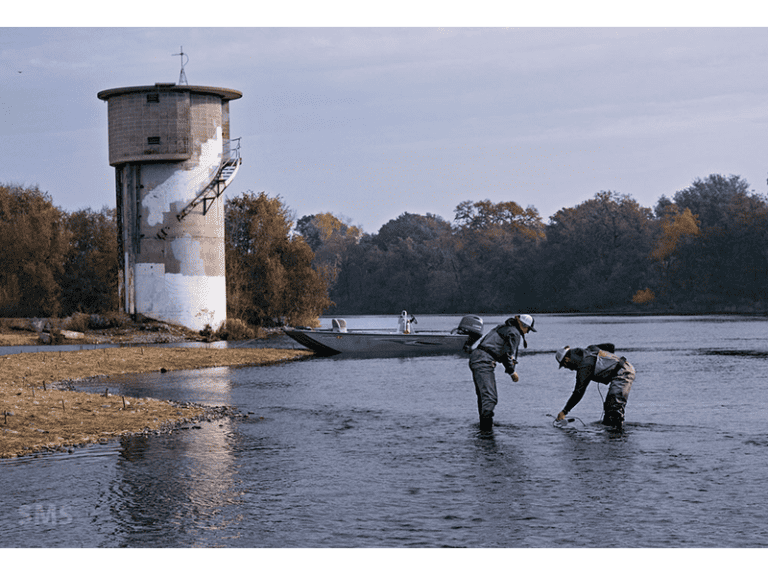Photo: Carmichael’s iconic water tower is a sentinel near a newly established salmon nesting habitat near Ancil Hoffman Park. Biologists Maeghen Wedgeworth and Matt Ziemer drop markers prior to measuring underwater nests. Photo by Susan Maxwell Skinner
SACRAMENTO REGION, CA (MPG) – Within weeks of a $3.6 million Water Forum project completion in October, giant chinook were spawning in new gravel beds beside Ancil Hoffman Park.
At the peak of the fall American River salmon run, biologists commissioned by the Forum counted more than 100 new redds (nests) in river reaches that have been less than hospitable for spawning for decades. Salmon were digging nurseries when this reporter joined the survey of six augmented acres at Upper River Bend. After salmon, steelhead will use the same breeding habitat. Another species benefitted by the project is Pacific Lamprey, that breed in the same habitat.
“Monitoring is important” explains Kirsten Sellheim, senior scientist for Cramer Fish Sciences. “We bring what we learn into the next project design. In spring, we’ll do more monitoring here to learn how juvenile fish are using side channels that were part of this project.
“River bend is further downstream from most of the Water Forum’s past projects. Close to Nimbus Dam, spawning areas get crowded; this can reduce embryo survival. With the River Bend project, we’re trying to spread out spawning opportunities. It’s likely that greater reproduction success could occur in less crowded areas.”
Begun in August, the ten-week gravel-moving project continued Federal and State-funded efforts to aid salmonids. At the end of their lifecycles, these threatened species must have movable stones in oxygenated water for nesting and fertilization. To this end, 23,000 cubic yards of small-diameter gravel were moved from adjacent areas to form riffles and provide hospitable shallows.
The project includes a long, man-made side channel where hatchlings can feed and grow.
For millions of years, salmonids maintained their species unaided. The American River and its tributaries once offered 200 miles of breeding sites. Gold Rush and damming alterations have reduced possibilities to 12 viable miles.
Dams don’t just block spawning paths; they also bar natural gravel movement. “The lower part of the American River is gravel-starved,” explains Water Forum Habitat Manager Erica Bishop. “Some salmon and steelhead reach home waters and can’t find a place with the right physical conditions for spawning.”
“Though the Nimbus Hatchery will always have a role in juvenile fish production, our focus is to help fish complete life cycles naturally.”
The current project wrapped just as the first migrating salmon reached Upper River Bend. Results were immediate. “Our first survey in October showed only a few redds in the area,” says Sellheim. “Within a month, the numbers had skyrocketed. We know from 15 years of augmentation projects that […]
Full article: www.carmichaeltimes.com

